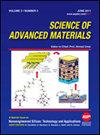Effect of Surface Nanomodification of Titanium Implants on Adhesion, Bone Bonding, and Bacterial Aggregation of Gingival Epithelial Cells and Fibroblasts
IF 0.9
4区 材料科学
引用次数: 0
Abstract
Implant-supported dentures have become a major approach to edentulous/defective repair. Peri-implantitis is a major factor leading to implant failure. The emergence of antibacterial peptides has provided a novel idea for the study of antibacterial coatings on implant surfaces. The antibacterial peptide GL13K was modified onto the surface of titanium (Ti) by silanization with 3-chloropropyltriethoxysilane, and its physicochemical properties were characterized. After its coculture with Porphyromonas gingivalis (P. g) in vitro , the cell activity was detected, and the antibacterial properties were analyzed. After its coculture with gingival fibroblasts (GFs) in vitro , CCK-8 was adopted to detect cell proliferation and analyze cytotoxicity. After its coculture with gingival epithelial cells (GECs) and GFs in vitro , the adhesion was demonstrated by acridine orange staining and DAPI staining. The smooth Ti implant (S/T), the microgroove Ti implant (E/T), and the GL13K-modified microgroove Ti implant (GL13K/E/T) were implanted into the inferolateral aspect of the femoral condyle of the right posterior limb of healthy New Zealand rabbits. Four weeks after surgery, the levels of osteoprotegerin (OPG) and nuclear factor-kappa B ligand (RANKL) in the bone tissue around the implant were detected by immunohistochemistry. The results revealed that relative to the S/T and E/T materials, the surface roughness and contact angle of the GL13K/E/T material were enhanced, while the metabolic activity and colony count of P. g were decreased. S/T, E/T, and GL13K/E/T materials had no notable effect on the viability of GFs ( P > 0.05). Relative to the S/T material, the numbers of GECs and GFs attached to the surfaces of the E/T and GL13K/E/T materials were drastically increased ( P < 0.05). Furthermore, relative to the S/T group, OPG levels in the peri-implant bone tissues of the E/T and GL13K/E/T groups were increased, while the RANKL level was decreased ( P < 0.05). In contrast to group E/T, OPG in the peri-implant bone tissue of rabbits of the GL13K/E/T group was increased, while the RANKL was decreased ( P < 0.05). In summary, the Ti implant with a microgroove structure modified by the antibacterial peptide GL13K had an ideal antibacterial effect and promoted the adhesion and growth of GECs and GFs. In addition, the antibacterial peptide GL13K-modified Ti implant with a microgroove structure could promote early bone bonding.钛种植体表面纳米修饰对牙龈上皮细胞和成纤维细胞粘附、骨结合和细菌聚集的影响
种植义齿已经成为修复无牙缺陷的主要方法。种植体周围炎是导致种植体失败的主要因素。抗菌肽的出现为种植体表面抗菌涂层的研究提供了新的思路。用3-氯丙基三乙氧基硅烷对抗菌肽GL13K进行了硅烷化修饰,并对其理化性质进行了表征。体外与牙龈卟啉单胞菌(Porphyromonas gingivalis, P. g)共培养,检测细胞活性,分析抗菌性能。CCK-8与牙龈成纤维细胞(GFs)体外共培养后,检测细胞增殖并分析细胞毒性。体外培养龈上皮细胞(GECs)和龈上皮细胞(GFs)后,吖啶橙染色和DAPI染色显示其黏附。将光滑型钛种植体(S/T)、微槽型钛种植体(E/T)和GL13K修饰型微槽型钛种植体(GL13K/E/T)植入健康新西兰兔右后肢股骨髁内外侧。术后4周,采用免疫组化方法检测种植体周围骨组织中骨保护素(OPG)和核因子- κ B配体(RANKL)水平。结果表明,相对于S/T和E/T材料,GL13K/E/T材料的表面粗糙度和接触角增强,而P. g的代谢活性和菌落计数降低。S/T、E/T和GL13K/E/T材料对GFs活力无显著影响(P >0.05)。与S/T材料相比,E/T和GL13K/E/T材料表面附着的gec和GFs数量急剧增加(P <0.05)。此外,与S/T组相比,E/T组和GL13K/E/T组种植体周围骨组织中OPG水平升高,RANKL水平降低(P <0.05)。与E/T组相比,GL13K/E/T组家兔种植体周围骨组织OPG升高,RANKL降低(P <0.05)。综上所述,抗菌肽GL13K修饰微槽结构的Ti植入物具有理想的抗菌效果,促进了gec和GFs的粘附和生长。此外,抗菌肽gl13k修饰的Ti种植体具有微槽结构,可以促进早期骨结合。
本文章由计算机程序翻译,如有差异,请以英文原文为准。
求助全文
约1分钟内获得全文
求助全文
来源期刊

Science of Advanced Materials
NANOSCIENCE & NANOTECHNOLOGY-MATERIALS SCIENCE, MULTIDISCIPLINARY
自引率
11.10%
发文量
98
审稿时长
4.4 months
 求助内容:
求助内容: 应助结果提醒方式:
应助结果提醒方式:


